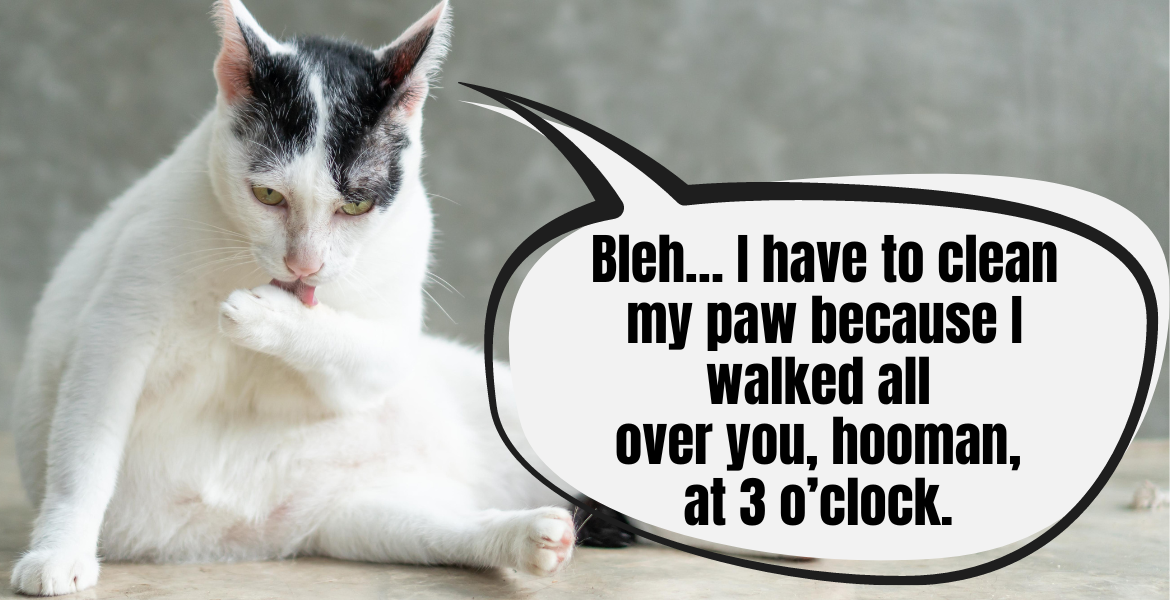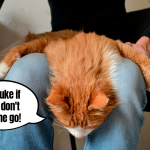Cats have mastered the art of personal hygiene to purrfection. Apart from minor mishaps, health problems, or specific breed requirements, most furballs keep their bodies clean without human assistance, water, or an arsenal of cosmetics. With a tongue serving as a brush and agility that many gymnasts would envy, cats learn from a young age to care for the cleanliness of their fur, paws, and the sun hidden under their tails. Unfortunately, sometimes cats can go too far with personal hygiene, harming themselves by licking their fur down to the skin and causing injuries. What could be the cause of such behavior, and how can we help a cat unravel problems with the need for excessive grooming? Let’s find out.
Excessive licking: cleanliness or a health issue?
Grooming is as natural for cats as chasing flies on the window, napping after a meal, or sharpening claws on a scratching post—they always find time for it in their daily schedule. Grooming helps cats clean their fur, care for the skin, detangle and remove dead hair, and cool off on hot days. During a “bath,” a cat will lick and nibble their fur and skin—this allows them to reach areas that require more attention or to relieve themselves when something itches. Within one grooming session, a cat may undertake to clean their entire body or focus on specific parts, depending on preferences. There is a method to this madness!
How much of the day do cats spend grooming? It depends, of course, on the cat, fur type, and living conditions, but for some furballs, it could be as much as a third of their daily activities. That’s quite a lot, considering how meticulous cats are—one might assume they don’t need to dedicate as much time to hygiene. So why is grooming such an important part of a cat’s schedule?
A bath for soothing nerves: that’s how cats relax
As it turns out, grooming is not just about keeping the fur clean and maintaining the skin’s good condition. For cats, personal hygiene is a calming mechanism—cats may start grooming immediately after a stressful situation when they are scared, confused, or unsure how to behave. It’s in this context that cats often go too far with hygiene. When there’s too much stress and reasons to worry in their lives, a cat may develop an unhealthy habit of excessive licking to soothe their nerves with such intensity that they start removing healthy fur until bald patches of skin appear, and even serious skin irritations.
Why do cats overgroom themselves?
Excessive grooming can have medical, behavioral, or a combination of both origins. So if you notice your cat excessively licking in a specific area of the body or if bald patches of skin appear where there should be fur, be sure to consult a veterinarian and observe in which situations your cat focuses all their energy and attention on grooming the problematic area.
Your cat may excessively lick its fur due to:
Physical pain. You might observe such behavior after your cat sprains a paw or when something gets embedded in their body, but overgrooming can also be a sign of internal pain symptoms. The belly or the area around and under the tail are most often the victims of overgrooming, and the causes may include bladder inflammation, back problems, clogged anal glands, or kidney issues.
Skin issues, including allergic reactions, infections, inflammations, or parasite invasions, such as fleas or ticks. Such problems should not be ignored, even if you use preventive measures against parasites. Schedule a visit to a feline dermatologist as soon as possible because if the problem is a food or environmental allergic reaction, eliminating the source of the problem may take time. And you don’t want your kitty to suffer unnecessarily.
Behavioral reasons, like stress, fear, and life difficulties we’ve described previously. A cat may resort to familiar ways of calming down when another cat enters their territory and they feel threatened (and proper socialization with isolation does not occur), after moving, after losing a loved one (or a feline friend), due to regular visits to the veterinary office, frequent travels, and many others. Sometimes, cats excessively groom themselves due to frustration—when they can’t release their energy or play doesn’t satisfy their hunting needs. Behavioral problems can also be combined with physical pain, so it’s always worth taking your cat for basic tests at the veterinary office before talking to a behaviorist.
Visible signs of excessive grooming in cats
When your cat starts removing healthy fur and grooming until they reach the skin, you definitely won’t overlook it, fabCat. Cats are masters of hiding discomfort, but overgrooming is one of the more visible signals that something is wrong. Bald patches of skin are already a sufficient sign that your kitty isn’t feeling their best. In addition to visible holes in the fur, you may also notice:
- noticeable thinning of the fur,
- red skin,
- scratching in excessively licked areas (which may be another symptom of allergic problems),
- scabs,
- clumps of pulled-out fur in places where the cat spends most of their time,
- decreased activity or hyperactivity,
- decreased or increased appetite beyond the norm.
Checking off even one item on the above list should trigger alarm bells in your head, fabCat. Dermatological problems are often ignored because, after all, everyone has to scratch themselves sometimes. However, we recommend not trivializing the matter—it’s better to visit the veterinary office more often than to risk expensive treatment if complications from an untreated condition occur.
What is it like to work with a cat that overgrooms themself?
There is no one simple recipe for solving a cat’s problem of excessive licking, regardless of its cause. Sometimes pharmacological treatment and elimination of allergens will be necessary, while other times, a behavioral consultation is a must. One thing is certain, fabCat: if your cat has a problem, don’t try to forcibly stop them from grooming—yelling or pulling the cat away from grooming themself won’t work for long and may only alienate the cat from you, increasing the stress they already feel. Ensure that your cat has the calmest and most friendly environment possible. Try to eliminate potential stressors. Play with your cat to satisfy their natural needs, release energy, and establish a daily routine with the cat. Don’t let the cat get bored—lack of occupation can lead to overgrooming when the cat is frustrated and looking for ways to kill time. Take active action with the support of specialists—we’re rooting for you!
Have you, fabCats, ever observed your cats and their grooming habits? Or have you had a case of overgrooming in your home and had to work on it? Share your stories in the comments! 




